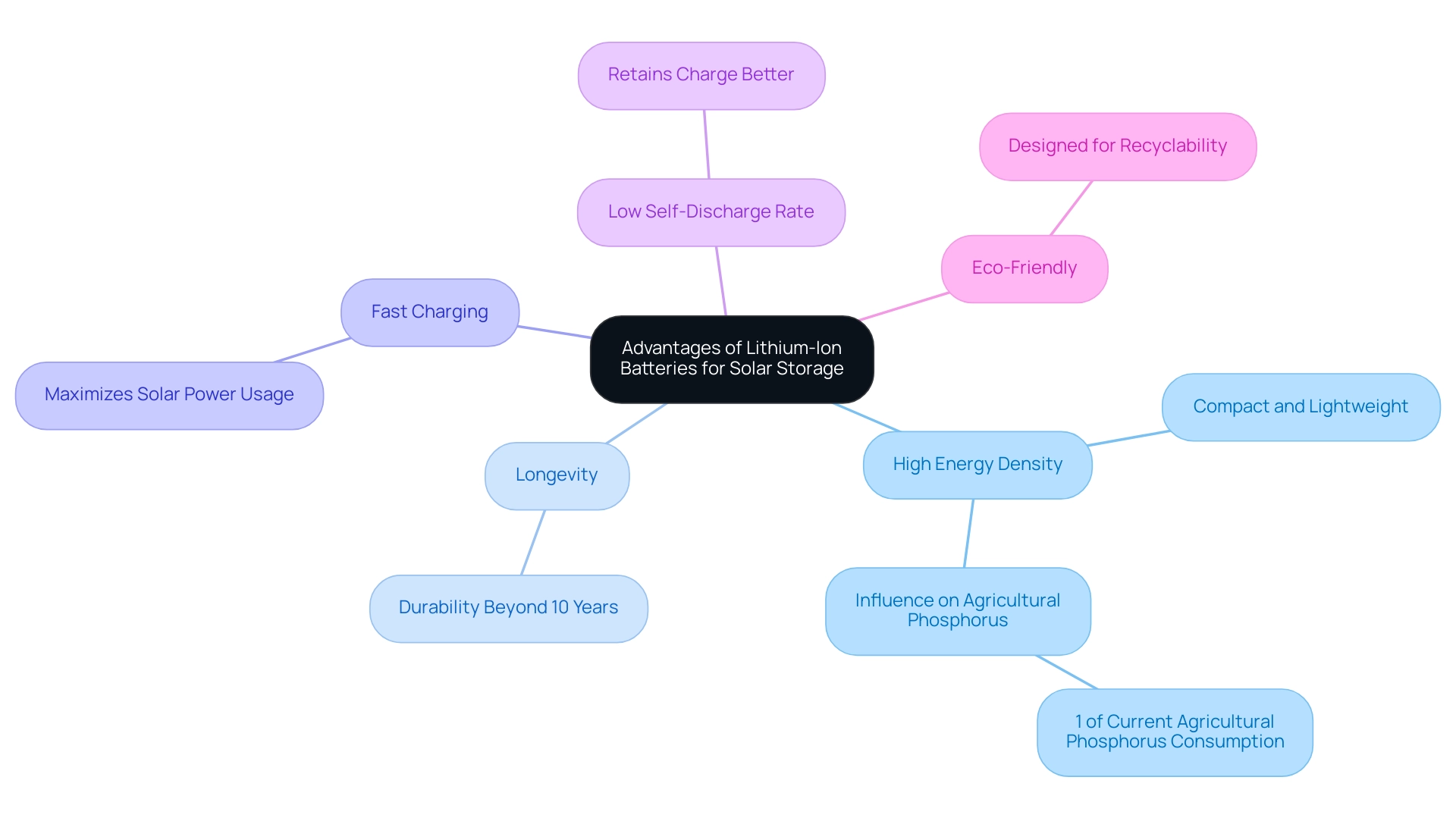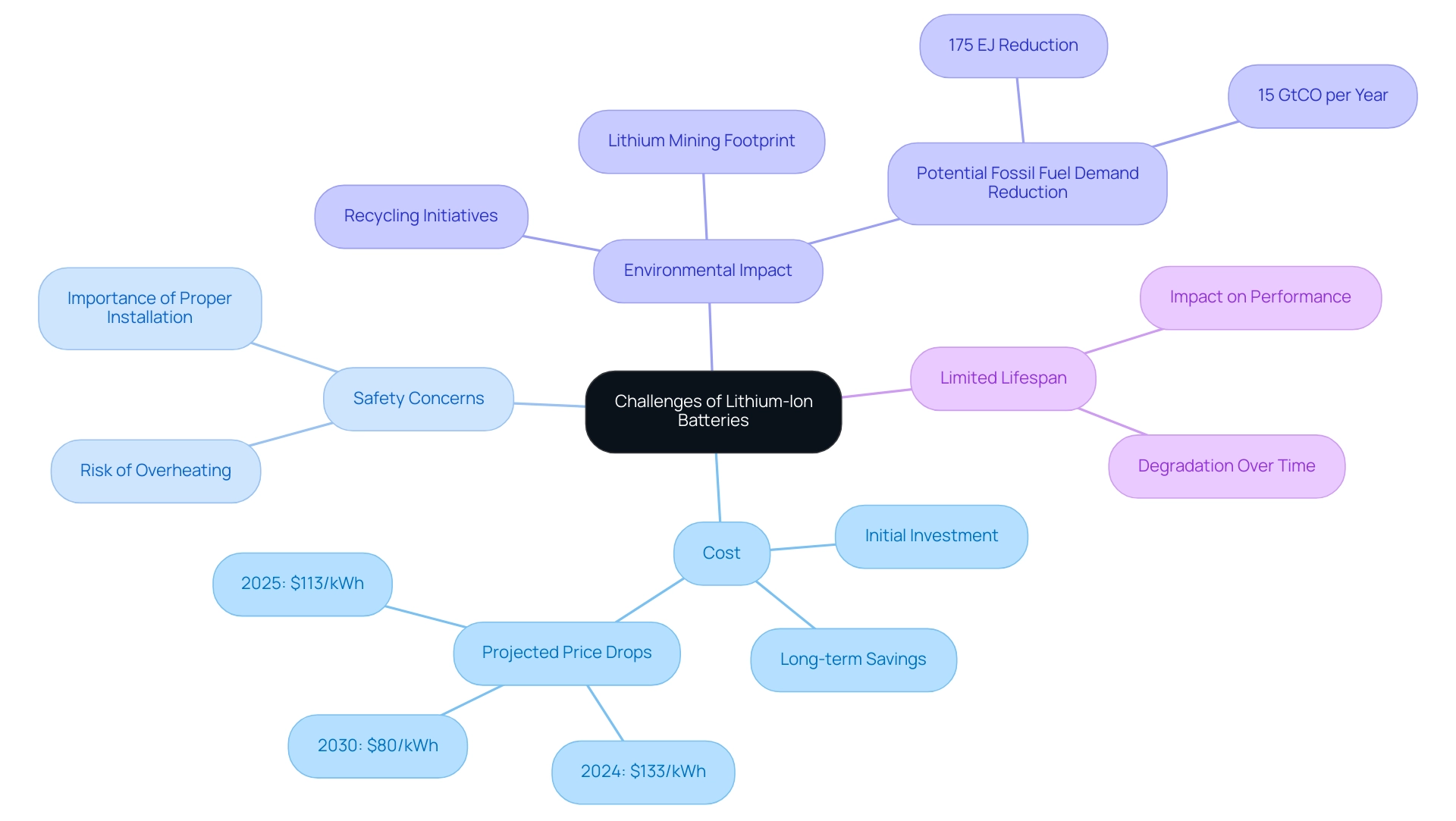Introduction
In the quest for sustainable living, lithium-ion batteries have emerged as a game-changer for solar energy systems, offering homeowners a reliable way to harness and store renewable energy. These innovative batteries not only capture excess power generated during sunny days, but they also ensure that energy is readily available when the sun goes down or on cloudy days.
With their lightweight design and high energy density, they seamlessly fit into residential settings, making solar energy more accessible than ever. As advancements in technology continue to enhance their efficiency and affordability, understanding the benefits, challenges, and future trends of lithium-ion batteries becomes essential for homeowners looking to make informed decisions about their energy solutions.
Whether navigating the complexities of installation or exploring the latest innovations, the journey toward a greener home starts with these powerful energy storage devices.
Introduction to Lithium-Ion Batteries in Solar Energy
Lithium-ion batteries have become the favored option for solar storage in photovoltaic systems, specifically as a lithium ion battery for solar storage, and for good reason! These rechargeable gadgets utilize a lithium ion battery for solar storage to excel at storing surplus power produced by sunlight collectors during bright days, enabling residents to utilize that power at night or on those less sunny days. Their lightweight design and high power density make them especially appropriate for home environments, ensuring that you can capture sunlight without the bulk.
Beyond their practicality, these power sources are celebrated for their impressive efficiency and low maintenance needs, which are significant advantages for eco-conscious residents. In California, the transformative impact of building codes and NEM 3.0 has further accelerated solar energy adoption, creating more opportunities for homeowners to invest in sustainable solutions. It’s important to note that as of 2023, China utilized less than 40% of its maximum cell output, highlighting a significant opportunity for growth in the lithium ion battery for solar storage market.
With lithium carbonate prices sitting at about 50% higher than their 2015-2020 average, the market for these batteries is evolving rapidly. The Low Battery Case could result in greater dependence on coal and natural gas, significantly increasing fuel import costs and endangering renewable objectives by 2030. As Mücahid Candan, a guest researcher at the Fraunhofer Institute for Solar Energy, points out, advancements in lithium ion battery for solar storage technology are continuously enhancing their performance.
This makes them not just a smart choice for energy storage, but also a crucial component in the quest for sustainable living. The risks connected to inadequate storage capacity highlight the urgency of investing in a lithium ion battery for solar storage technology. So, whether you’re in California or elsewhere, investing in a lithium ion battery for solar storage can be a significant step toward creating a greener home.
Furthermore, to enhance the effectiveness of your power system, think about utilizing eco-friendly cleaning alternatives like biodegradable soap solutions or specific panel cleaning kits that are safe for the environment. These methods ensure that your panels remain free of dirt and debris, allowing them to operate at peak performance.
Advantages of Lithium-Ion Batteries for Solar Storage
Lithium-ion cells offer numerous advantages that render them a superb option as a lithium ion battery for solar storage. Here’s why these batteries are a top pick for eco-conscious homeowners:
- High Energy Density: One of the standout features of lithium-ion cells is their ability to store an impressive amount of power in a compact, lightweight package. This means you can get more power without taking up too much space. Indeed, if all cells today were lithium iron phosphate (LFP), they would represent nearly 1% of current agricultural phosphorus consumption by mass, emphasizing their substantial influence on storage technology.
- Longevity: With proper maintenance, these units can endure beyond 10 years, offering a dependable power solution that yields benefits in the long term. Imagine having a dependable source of power for a decade!
- Fast Charging: Lithium-ion cells excel at rapid charging, which improves efficiency. This feature enables you to maximize your solar power, particularly during peak sunlight hours.
- Low Self-Discharge Rate: When not in use, lithium-ion cells retain their charge much better than many other types. This means your stored energy is ready when you need it, without the worry of losing power over time.
- Eco-Friendly: Many lithium-ion cells are designed with recyclability in mind, making them an environmentally responsible choice. By choosing these power sources, you’re contributing to sustainability efforts while enjoying modern technology.
When comparing lithium-ion cells to other types, such as lead-acid or nickel-metal hydride, the lithium ion battery for solar storage generally provides superior energy density and longer lifespan, making it a more efficient choice for solar energy applications.
Additionally, as you explore options, it’s important to consider regional price variations. Prices for energy storage units differ greatly across areas, with China offering the lowest average costs due to its dominance in cell and cathode production. This price discrepancy could influence your purchasing decisions as an eco-conscious homeowner.
As Kingsmill Bond points out, “This energy storage domino effect is set to enable the rapid phaseout of half of global fossil fuel demand and be instrumental in abating transport and power emissions.” With energy cell growth and enhancement happening at a quicker pace than analysts’ consensus perspectives, the benefits of lithium-ion energy storage in photovoltaic applications are becoming more evident than ever. With their blend of power density, longevity, and eco-friendliness, lithium ion batteries for solar storage genuinely stand out as a wise investment for your photovoltaic system.
To further demonstrate the effectiveness of lithium-ion cells, consider testimonials from residents who have successfully integrated them into their solar systems, reporting substantial savings on utility costs and enhanced reliability in power supply.
Challenges and Limitations of Lithium-Ion Batteries
Lithium-ion batteries, while celebrated for their efficiency and reliability, present a few challenges that eco-conscious homeowners should consider:
- Cost: The initial investment for lithium-ion cells can be steep, but many residents find that the long-term savings on utility bills can more than compensate for this upfront expense. In fact, as BloombergNEF projects, energy storage pack prices are expected to decline significantly—forecasting a drop to $133/kWh in 2024, $113/kWh in 2025, and an impressive $80/kWh by 2030, thanks to ongoing technological advancements. This trend is especially significant for homeowners contemplating Tesla home chargers, which can enhance energy usage when combined with a lithium ion battery for solar storage.
- Safety Concerns: Safety is a critical factor when it comes to lithium-ion cells. If not properly managed, there is a risk of overheating and even fire incidents. For example, a recent case involving an overheating power source in a residential setting highlights the importance of proper installation and monitoring. As Yayoi Sekine, head of power storage at BNEF, points out, “Prices of storage units have been on a roller coaster over the past two years… we’re keenly observing how production incentives and tightening regulations on essential minerals will affect storage costs.” This emphasizes the need for vigilance and proper handling, especially in light of the complexities arising from these price fluctuations.
- Environmental Impact: The environmental footprint of lithium mining cannot be overlooked. While there are recycling initiatives underway aimed at reducing this impact, the extraction process can still have detrimental effects on local ecosystems. In fact, the incorporation of energy storage systems into the electricity sector could potentially reduce a further 175 EJ of fossil fuel demand, equating to almost 15 GtCO per year. It’s crucial to remain knowledgeable about the sourcing of materials and to support manufacturers dedicated to sustainable practices, such as those using a lithium ion battery for solar storage in government programs promoting eco-friendly power solutions.
- Limited Lifespan: Despite their reputation for longevity, lithium-ion batteries do degrade over time. Homeowners should be aware that their efficiency may diminish, which can affect overall performance and power storage. This is a significant factor when planning for long-term power solutions.
Tackling these challenges necessitates a proactive strategy, as ongoing advancements in energy storage technology will rely on the joint efforts of corporations, governments, researchers, and climate advocates. By staying updated on government incentives and making informed decisions, property owners can manage these complexities and enhance the advantages of renewable power storage, including the efficient use of Tesla home chargers.
Applications of Lithium-Ion Batteries in Solar Systems
Lithium-ion cells are vital components in the photovoltaic sector, offering various advantages that enable homeowners to optimize their systems. Here’s how they contribute:
- Energy Storage: The lithium ion battery for solar storage effectively retains surplus power produced by solar panels, guaranteeing that you have electricity accessible when it is most essential. This capability not only improves your autonomy but also assists in managing consumption during peak times with a lithium ion battery for solar storage.
- Grid Independence: With a dependable lithium ion battery for solar storage, homeowners can utilize stored power during outages or peak demand times, thereby decreasing their reliance on the grid. This shift is essential, particularly given that yearly increments of grid-scale energy storage must average close to 120 GW per year from 2023 to 2030 to achieve Net Zero goals, emphasizing the urgency of investing in storage solutions.
- Off-Grid Solutions: For individuals residing in isolated regions where grid connections are unfeasible, a lithium ion battery for solar storage provides a self-sustaining power source, enabling you to experience the advantages of solar power without the limitations of conventional electrical infrastructure.
- Smart Energy Management: Many contemporary power storage systems integrate seamlessly with smart home technology. This setup empowers homeowners to monitor and optimize their energy usage in real time, making it easier to manage consumption and maximize savings.
- Choosing the Appropriate Power Source: When selecting a photovoltaic storage unit, consider factors such as capacity, discharge rate, warranty, and the inclusion of a lithium ion battery for solar storage. Look for power sources that offer a good balance of price and performance, and check for certifications that ensure quality and safety. User manuals often provide detailed specifications and recommendations tailored to various solar setups, making them valuable resources for homeowners.
As industry leaders have observed, power sources like lithium ion battery for solar storage are a ‘master key’ that can unlock significant transformations in usage and sustainability, particularly in the context of enhancing grid independence and resource management. Furthermore, with the growing emphasis on economic benefits and sustainability, recycling presents a significant opportunity to supply critical minerals sustainably and reduce geographic concentration risks, fostering a more resilient supply chain. With storage investments anticipated to exceed USD 35 billion in 2023, now is the ideal moment for eco-conscious homeowners to investigate how a lithium ion battery for solar storage can enhance your home’s power efficiency and resilience.
Future Trends in Lithium-Ion Battery Technology for Solar Energy
As we look ahead in the realm of solar energy storage, particularly with lithium-ion battery technology, several exciting trends are shaping its future for homeowners:
- Improved Efficiency: A significant focus on enhancing battery performance is underway, allowing for greater power storage capacity. For instance, in 2023, China utilized less than 40% of its maximum cell output, underscoring the potential for increased efficiency. This indicates you, as a homeowner, can store more solar power, ensuring it’s accessible when you require it the most. Notable products like the Tesla Powerwall and LG Chem RESU, which are high efficiency options, exemplify the use of lithium ion battery for solar storage.
- Enhanced Safety Features: Innovations are actively addressing safety concerns, especially regarding overheating. The batteries of today are fitted with sophisticated safety attributes aimed at reducing these hazards, offering a dependable power source for your home. The Enphase Encharge, for example, includes built-in safety mechanisms that ensure safe operation.
- Expanded Recycling Programs: With sustainability at the forefront, there’s a growing emphasis on recycling lithium-ion cells. This initiative not only reduces waste but also fosters a greener energy future. As recycling technologies advance, we expect more efficient methods that recover valuable materials from used energy cells. Homeowners can consider brands like Sonnen, which promote recycling and sustainable practices in their energy storage systems.
- Integration with Renewable Sources: Future battery systems are set to harmonize with other renewable technologies, including wind and hydro. This comprehensive approach will empower homeowners to effectively harness multiple renewable sources, enhancing energy independence. Products like the Generac PWRcell are designed to integrate seamlessly with solar and other renewable systems.
- Emergence of Sodium-Ion Cells: Sodium-ion cells, viewed as a promising alternative to lithium-ion technology, are being developed by industry leaders like BYD, Northvolt, and CATL. If successful, these batteries could be produced at up to 20% lower costs than current options, making them suitable for urban applications and improving power security. While still in development, keep an eye on these innovations as they may soon offer cost-effective alternatives for property owners.
These trends are paving the way for a more efficient, safe, and sustainable future in renewable power. As highlighted, ‘Green innovations in lithium ion battery for solar storage technology are transforming the landscape of energy storage,’ emphasizing the significance of these advancements for individuals seeking to maximize their solar efficiency. By considering products like the Tesla Powerwall, LG Chem RESU, and Generac PWRcell, homeowners can make informed choices that align with these trends.
Conclusion
Lithium-ion batteries are positioned at the forefront of the transition to sustainable energy solutions for homeowners. Their ability to efficiently store excess solar energy not only empowers individuals to utilize renewable resources but also enhances energy independence during peak demand times or outages. With benefits like high energy density, longevity, and eco-friendliness, these batteries present a compelling option for those looking to invest in solar energy systems.
However, it’s crucial to remain aware of the challenges that accompany this technology, such as initial costs and safety considerations. As advancements continue to reshape the landscape of lithium-ion batteries, including improved efficiency and enhanced safety features, the potential for these systems to contribute significantly to sustainable living becomes even clearer.
As the market evolves, with trends pointing toward increased recycling and integration with diverse renewable sources, homeowners have a unique opportunity to be at the forefront of this energy revolution. Investing in lithium-ion battery technology not only supports personal energy goals but also contributes to broader environmental objectives. Embracing these advancements ensures a greener, more sustainable future for generations to come.




